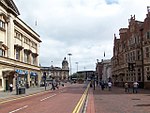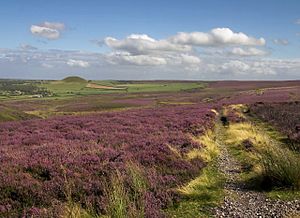Portal:Yorkshire
The Yorkshire Portal
Yorkshire (/ˈjɔːrkʃər, -ʃɪər/ YORK-shər, -sheer) is an area of Northern England which was historically a county. Despite no longer being used for administration, Yorkshire retains a strong regional identity. The county was named after its original county town, the city of York.
The south-west of Yorkshire is densely populated, and includes the cities of Leeds, Sheffield, Bradford, Doncaster and Wakefield. The north and east of the county are more sparsely populated, however the north-east includes the southern part of the Teesside conurbation, and the port city of Kingston upon Hull is located in the south-east. York is located near the centre of the county. Yorkshire has a coastline to the North Sea to the east. The North York Moors occupy the north-east of the county, and the centre contains the Vale of Mowbray in the north and the Vale of York in the south. The west contains part of the Pennines, which form the Yorkshire Dales in the north-west. (Full article...)
Selected article

Kingston upon Hull, almost invariably referred to as Hull, is a city and unitary authority area in the East Riding of Yorkshire, England. It is located on the north bank of the Humber estuary, near the Yorkshire coast. Sited 25 miles (40 km) from the North Sea, on both sides of the River Hull at its junction with the Humber, the city has a resident population of (2022). Renamed Kings town upon Hull by King Edward I in 1299, Hull has served as market town, trading hub, fishing and whaling centre, and industrial metropolis. Hull was an early theatre of battle in the English Civil Wars, and was the backdrop to events leading to the abolition of the slave trade in Britain.
It was unique in the United Kingdom in having a municipally owned telephone system from 1902, sporting cream, not red, telephone boxes. After suffering heavy damage during the Second World War, Hull weathered a period of post-industrial decline, when the city gained unfavourable results on measures of social deprivation, education and policing.
However, the city has recently embarked on a programme of regeneration and renewal and a range of sporting and cultural activities is available, with attractions including the historic Old Town and Museum Quarter, Hull Marina and The Deep. (read more . . . )
Selected image

Credit: Colin Grice
The North York Moors is a national park in North Yorkshire. The moors are one of the largest expanses of heather moorland in the United Kingdom. (read more . . . )
Selected biography

Edwin was the son of Ælle king of Deira. His sister Acha was married to Æthelfrith, king of neighbouring Bernicia. An otherwise unknown sibling fathered Hereric, who in turn fathered Abbess Hilda of Whitby and Hereswith, wife to king Anna of East Anglia's brother Æthelric. With the death of Æthelfrith, and of the powerful Æthelberht of Kent the same year, Raedwald and his client Edwin were well placed to dominate England, and indeed Raedwald did so until his death a decade later. Edwin annexed the minor British kingdom of Elmet following a campaign in either 616 or 626. Elmet had probably been subject to Mercia and then to Edwin. The much larger kingdom of Lindsey appears to have been taken over c. 625, after the death of king Raedwald. (read more . . . )
Selected list -

The Churches Conservation Trust, which was initially known as the Redundant Churches Fund, is a charity whose purpose is to protect historic churches at risk, those that have been made redundant by the Church of England. The Trust was established by the Pastoral Measure of 1968. The legally defined object of the Trust is "the preservation, in the interests of the nation and the Church of England, of churches and parts of churches of historic and archaeological interest or architectural quality vested in the Fund ... together with their contents so vested".
The Trust cares for over 350 churches. The charity is financed partly by the Department for Culture, Media and Sport and the Church Commissioners, but grants from those bodies were frozen in 2001, since when additional funding has come from other sources, including the general public. During the 2016-2017 period, the Trust's income was £9,184,283 and expenditures totaled £9,189,061; 92% of the latter was spent on front line projects. During that year it had 64 employees, and received the support of up to 2,000 volunteers. The charity is run by a board of trustees, who delegate the day-to-day management to a chief executive and his senior management team. (Full article...)
List of selected lists
|
|---|
Selected Did You Know . . .

- ... that Fountains Fell, (pictured), a mountain in the Yorkshire Dales, England, is named after Fountains Abbey whose monks grazed sheep there in the 13th century?
- ...that the Rotunda Museum houses one of the foremost collections of Jurassic geology on the Yorkshire Coast?
- ... that All Saints Church, Helmsley, contains two chapels dedicated to different saints?
- ...that an estimated 20 people died after eating peppermint humbugs that were accidentally made with arsenic in the 1858 Bradford sweets poisoning?
General images -
Subcategories
Selected panorama

Topics
Related portals
WikiProjects
Things you can do
Associated Wikimedia
The following Wikimedia Foundation sister projects provide more on this subject:
-
Commons
Free media repository -
Wikibooks
Free textbooks and manuals -
Wikidata
Free knowledge base -
Wikinews
Free-content news -
Wikiquote
Collection of quotations -
Wikisource
Free-content library -
Wikiversity
Free learning tools -
Wikivoyage
Free travel guide -
Wiktionary
Dictionary and thesaurus



















































